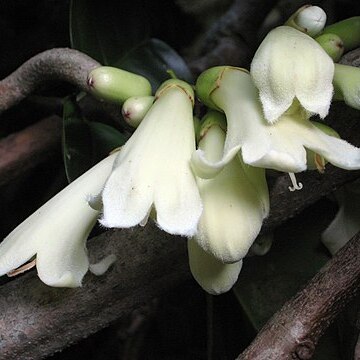Small to large lianas, climbing or creeping (in mountain heaths). Glands on twig-nodes small. Leaves 1-pinnate, 1-7-jugate; leaflets entire or toothed, underneath very finely punctate-glandular. Racemes short, pendent, from efoliate nodes on old wood, very rarely axillary or terminal; peduncle short, with some crowded, small, sterile bracts at base, in fruit thickening like a brachyblast; rachis short (up to c. 7(—13) cm); flowers opposite, in the axil of a small, narrow fugacious bract. Pedicels with 2 small, narrow bracteoles. Calyx closed in bud, persistent, c. 1½-4 cm, with 5 fairly large, deltoid ± equal lobes short-hairy along the margin, rarely split on one side. Corolla infundibuliform, the basal tube gradually widening upwards, ± straight, mostly pink, c. 5-12 cm long, inside near the insertion of the stamens stuppose or lax-hairy and sometimes with capitate-glandular papillae; limb mostly slightly zygomorphous, very rarely distinctly zygomorphous; lobes in bud narrowly imbricate, mostly deltoid. Stamens didynamous, mostly included, 5th rudimentary; anther-cells almost free, (in Mal.) c. 4 mm and almost always divaricate. Disk thick, annular. Ovary glabrous, in each of the 2 cells with rows of ovules attached on 2 placentas on the dissepiment; stigma long, filiform, with 2 spathulate stigmas. Capsule linear-terete or flattened, stipitate and beaked, with 2 coriaceous or almost woody, smooth, wide or very narrow boat-shaped valves. Seeds, orbicular, with fairly large, thin-membranous wings.
More
Infls short, axillary, mostly on old wood above lf-scars. Calyx campanulate to suburceolate, ± lobed; corolla-tube ± funnelform with large unequal lobes. Fifth stamen us. rudimentary. Ovary cylindric, flattened or subquadrangular, 2-locular, each loculus with 2 placentae. Capsule loculicidally dehiscent with 2 coriac. boat-shaped valves. Seeds winged. Woody lianes with 1-5-jugate glab. lvs. Some 20 spp. mainly of New Guinea. The N.Z. sp. endemic.
Primary and secondary rainforest, mossy forest and mountain heaths, from sea-level up to 3100 m.One collector noted honey in the flowers. It is likely that the diurnal flowers are bird-pollinated, but there are no records.Tecomanthe speciosa was derived from cuttings of the single plant found in nature. It has in cultivation produced flowers and can obviously propagate by self-pollination. The corolla is sometimes (in the herbarium) already ± open before full maturity. In one case rather long, unbranched, pendent, aerial roots were observed emitted from a node. In juvenile specimens leaves tend to be more toothed than in mature foliage.

